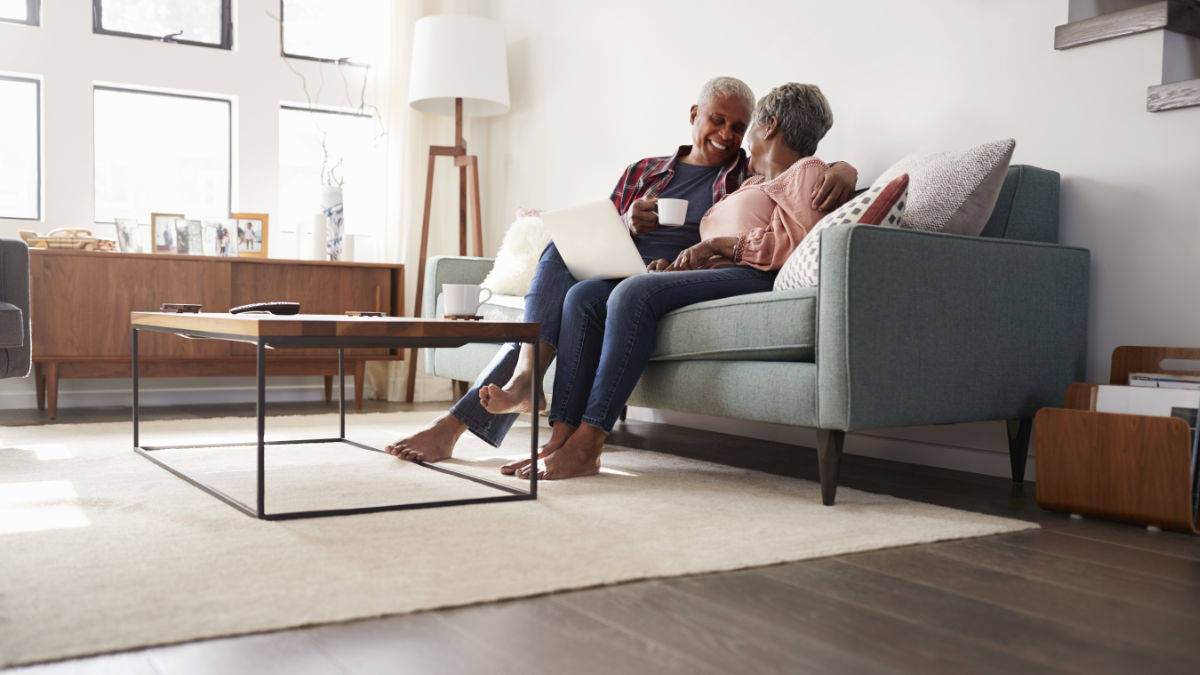Older people looking to move home, such as downsizing or simply moving to a new area to retire, can run into difficulties raising finance to buy a decent property. The government-back Older People’s Shared Ownership scheme can help – and save over 55s money when buying a home.
A recent study by Prudential found a lack of affordable property can prevent over 55s from downsizing and nearly 25% of over 55s cited the high cost of conveyancing solicitors, stamp duty and estate agents as a reason to not move.
If you’re struggling to raise money for a later life home move, the government-backed Older People’s Shared Ownership scheme could help you buy a home and keep payments affordable.
Designed to help people aged 55 and over buy a home as well as make the entire home-buying process easier, the Older People’s Shared Ownership scheme helps older home buyers from being priced out of the housing market.
With over 11m homeowners in the UK, the Older People’s Shared Ownership scheme can be useful for last time buyers who need help moving from a family home but who struggle to raise a mortgage due to lower income. It’s also aimed at over 55s who may have divorced from their spouse or whose partner has died to be able to buy a decent home with an affordable mortgage.
Read our guide to retirement homes: choosing the right one for you – what to look for, questions to ask and retirement home costs and benefits.
What is the Older People’s Shared Ownership scheme?
The Older People’s Shared Ownership scheme – known as OPSO – is similar to the government’s shared ownership scheme. It allows you to buy a home on a shared ownership basis. This means that instead of taking a mortgage out on the entire value of the property, you can buy between 25% and 75% of the value of a home within a Housing Association. The remaining percentage is owned by the housing association and you’ll pay subsidised rent on the percentage of the home you don’t own.
Many modern developments, including houses and flats, include a percentage of shared ownership housing. There are also dedicated shared ownership developments springing up across England.
Unlike traditional shared ownership schemes, the Older People’s Shared Ownership scheme offers better value. If you purchase less than a 75% stake in the property, you’ll need to pay rent on the remainder. However, when you buy the maximum of 75%, the need to pay rent is removed entirely. This significantly reduces the overall cost of buying your own home, effectively allowing you to live rent-free.
Don’t worry if you can’t afford to buy 75% of the property from the get-go. You can increase the percentage you own over time. This is known as ‘staircasing’ and makes an affordable way to increase your ownership of your home without the upfront expense.
The Older People’s Shared Ownership scheme can significantly reduce the cost of a mortgage as well. Instead of having to arrange a mortgage for the full value of the property, you only to need to get a mortgage to cover the percentage you buy – and that can be as low as 25 per cent.
Older People’s Shared Ownership scheme example:
[table id=1 /]
In the example above, you’d save around £721 per month by buying 25% of a home and renting the remainder from a Housing Association compared to buying the entire property with a 100% mortgage. The total cost each month would be £1,005, compared to monthly mortgage repayments of £1,726.
The Older People’s Shared Ownership scheme also makes arranging a mortgage easier. Many banks won’t offer you a mortgage beyond nominated retirement age – usually around 15 years at age 55 – which means you need to get a shorter-term mortgage and that means higher monthly repayments.
By taking a mortgage against a smaller percentage of the property, monthly repayments are significantly less and you’ll have a wider choice of mortgages available.
How to apply for the Older People’s Shared Ownership scheme
You must be aged over 55 to apply for Older People’s Shared Ownership scheme. Other criteria include:
- You must currently be living in England;
- Your household income must be less than £80,000 in England, or less than £90,000 if currently living in London;
- You must have no outstanding credit issues, such as County Court Judgements or outstanding disputed debts;
- Be willing to sell your existing property before buying a new home through the Older People’s Shared Ownership scheme;
- Be either a first-time buyer, or someone who used to own a home but now cannot afford to, or someone who owns an existing shared ownership scheme property and wants to move home.
Different local authorities may have additional criteria – usually driven by local housing needs which means some groups may get priority. It’s worth knowing that military personnel always get priority on the scheme.
Why buy a shared ownership home?
Shared ownership offers plenty of advantages. Once purchased, you’re free to live in the home as long as you want, providing welcome security. The rent on the outstanding percentage is usually excellent value and is priced below the market rate. As a rough guide, rent is usually around 2.75% of the value of the property each year. You also need less money for a deposit – usually just 5% of the price of the percentage share you’re buying, rather than the entire value of the property.
Location is important as well. Many modern developments in the heart of an expensive area have to build shared ownership housing as part of their ability to go ahead with the development. That means you could own a shared ownership home in a fantastic location surrounded by properties worth millions. You may also be able to defer the cost of any stamp duty. With 24 per cent of over 55s put off moving home because of the cost of stamp duty, being able to defer it is welcome news – and can usually be deferred until you own the full 75% share of the property.
Is specialist housing available?
There are different Older People’s Shared Ownership schemes available across England and many offer more specialised older person’s housing including sheltered accommodation. These are similar to managed retirement properties and are typically smaller homes or flats within a complex, with onsite wardens and access to care and support. While the schemes have different names, many are known as ‘Extra Care’ Older People’s Shared Ownership schemes. Some will also have community areas, and improved mobility features in the homes such as walk-in baths.
What happens if I want to sell or remortgage a shared ownership home?
Buying a home through the Older People’s Shared Ownership scheme doesn’t mean you’re stuck living in that property for the rest of your life. You are free to sell your property as you want – the only criteria being you must give ‘first refusal’ to buy to the Housing Association, and the Housing Association retains the right to actually find a buyer for your home.
You can also move from one shared ownership home to another as long as you’re still eligible under the Older People’s Shared Ownership scheme’s criteria.
It’s worth knowing that when you sell a shared ownership home, a percentage of the property’s value is also given over to the Housing Association. You’ll need to check any implications of later selling your home when you apply to your local Older People’s Shared Ownership scheme.
Even if you don’t want to sell, you can remortgage in a similar way to a non-shared ownership home. There are usually fewer mortgages catering to shared ownership homes, but many of the big banks and building societies do offer a range of mortgage options.
What is staircasing as part of shared ownership housing?
Staircasing means that over time you increase the percentage share of the property that you own. This is useful, as it means you can move into the home buying just a 25% share and, when finances allow, gradually start to increase the percentage you own up to a maximum of 75%.
There isn’t a flat fee for each additional percentage you subsequently buy. Instead, the market value and property prices in the local area are taken into consideration. If prices have gone up, you’ll pay more for each per cent than it cost you originally. However, if house prices fall, the amount you’d have to pay would actually reduce, and you could end up buying an increased share for less than you originally paid.
Should I buy a home via the Older People’s Shared Ownership scheme?
While buying a shared ownership home via the Older People’s Shared Ownership scheme, there are some things worth knowing. Even though you are renting a percentage of the property, owning a shared ownership home is more like being a leaseholder. That means you – and not the landlord or Housing Association – is responsible for the upkeep of the property, including any repairs or modifications such as fixing broken windows or replacing an old boiler.
There are also extra costs to bear in mind. As a leaseholder, you’ll be liable for ground rent and if you live in a block of flats or communal development you may also have to factor in service charges. Check first before you buy what the annual charges are likely to be. You’ll also need to pay for conveyancing solicitors, stamp duty (although this may be able to be deferred) and any mortgage fees.
How to apply for the Older People’s Shared Ownership scheme
You’ll need to apply directly through the local authority where you are looking to live, and the first stop will be contacting a Help To Buy agent. They will work with you to understand your needs and explain your options in more detail.
You can find a list of Help To Buy agents at the government’s Help To Buy website. The agent will assess your eligibility and is the person who can authorise your entry into the Older People’s Shared Ownership scheme.































































